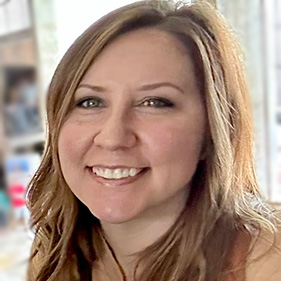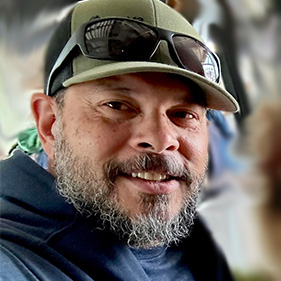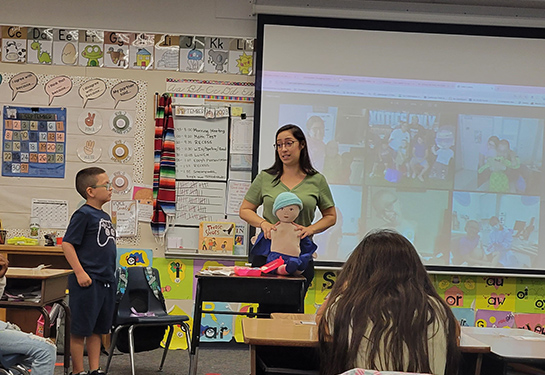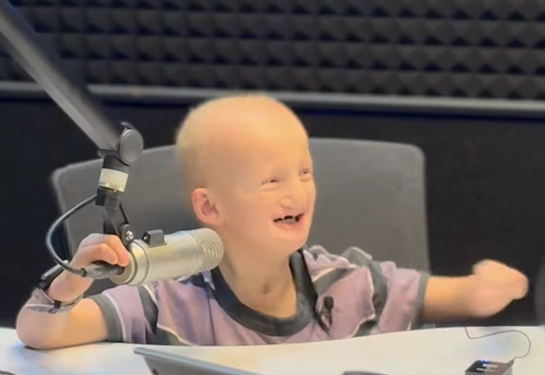Surgeons use collarbone to create new upper arm for young cancer patient
Exceptionally rare procedure called clavicula pro humero avoids amputation
When 9-year-old Sydney Engle was taken by ambulance to UC Davis Children’s Hospital after a broken arm, her parents knew the situation had to be something really serious.
“It was terrifying. Life changed in an instant,” recalled Sydney’s mom, Kacy Engle, of that whirlwind day in February 2023. “That morning, I thought it was just a pulled muscle. I figured that’s what they’d tell us. Then we found out her arm was broken, and that became the least of our worries.”
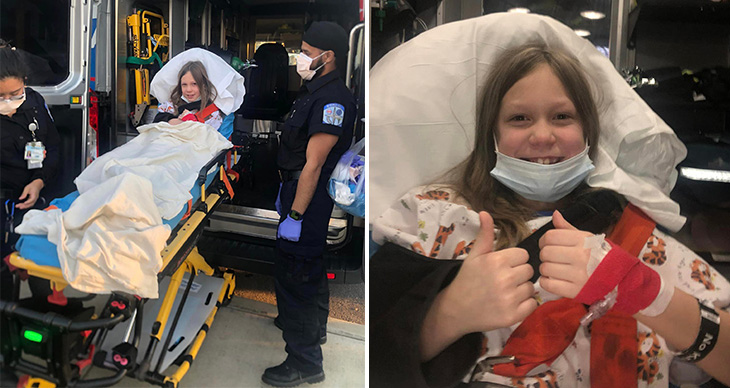
From bad to worse
For the Engles, it all started with a basketball game in San Joaquin County. Kacy and her husband, Jeremy, coached a girls team that included Sydney and her younger sister, Abigail. One day, a player popped the ball out of Sydney’s hand, which caused unexpected pain. Sydney grabbed her right arm and started crying.
“It was odd for her. Sydney’s not the type to cry in front of other kids,” Kacy said. “We knew something was wrong, but she wanted to continue playing.”
When Sydney bumped the same arm in the shower several weeks later, it hurt so badly that Kacy brought her to urgent care near their home in Escalon. That’s where the family got the news that Sydney had a broken arm. But there was more.
“The doctor looked like she had seen a ghost,” Kacy said. “Looking back, she likely knew what it was but couldn’t tell us.”
The Engles headed to the local hospital for more X-rays. Hours later, Sydney was in an ambulance on her way to UC Davis Children’s Hospital in Sacramento.
Diagnosis: Osteosarcoma
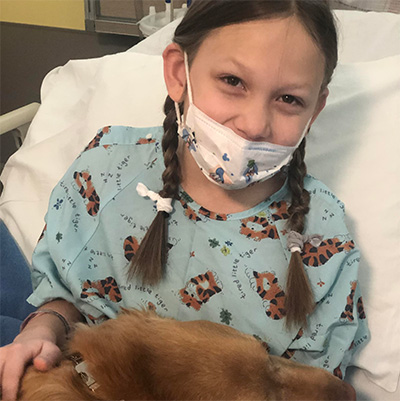
Further testing revealed Sydney had osteosarcoma, a type of bone cancer which tends to occur in teenagers and young adults but can also affect younger children. The most common symptoms are limited movement, bone pain, a lump and an unexplained broken arm or leg bone. The prognosis depends on a number of factors, but osteosarcoma requires rapid treatment to prevent it from spreading.
Treatment for osteosarcoma involves chemotherapy and surgery. Doctors select treatment options based on the location, size, type and grade of the osteosarcoma and whether the cancer has spread beyond the bone.
“Sydney had an aggressive osteosarcoma involving her shoulder of her dominant (right) arm. Because of the extent of her disease and her age, surgical options were quite challenging,” said UC Davis pediatric musculoskeletal surgical oncologist and Chair of Orthopaedic Surgery, R. Lor Randall. “You have to consider durability and the ability to grow with the child.”
We found out that people come from all over the U.S. to see Dr. Randall for surgery. We totally trusted him, 100%. We put our child in his hands knowing how serious he is about what he does.”—Kacy Engle, Sydney’s mom
Sydney started chemotherapy immediately and three months later, she would have surgery … but not before her parents had to make the hardest decision of their lives.
Options for surgery
The family was given several options, all involving surgery: Use part of Sydney’s collarbone to fix her arm or take a bone from her leg to use in her arm. Amputation was also discussed.
“The type of amputation she would need wouldn’t leave a nub for a prosthetic. They would have had to take from the middle of her shoulder almost to her neck,” Kacy said. “Her chances of survival would be best, but her quality of life would be compromised.”
It was a hard decision to make on behalf of their 9-year-old child. Kacy worried that her daughter would grow up without a limb and ask why her parents had not given her a chance at normalcy.
“It kept replaying in my mind,” Kacy said. “We decided amputation was not the right choice.”
The Engles opted instead for an uncommon surgery that would make a new upper arm using her collarbone.
We are now one of the most experienced teams in the world in utilizing this technique (clavicula pro humero).” —R. Lor Randall, UC Davis pediatric musculoskeletal surgical oncologist
“We found out that people come from all over the U.S. to see Dr. Randall for surgery,” Kacy said. “We totally trusted him, 100%. We put our child in his hands knowing how serious he is about what he does.”
Randall is one of relatively few physicians who have performed the exceptionally rare procedure called “clavicula pro humero.” In the procedure, the clavicle, or collarbone, is transposed with its blood supply off the central vessels to function as the upper arm and attachment to the rest of the body.
“I believe our team was the first to do this in the United States years ago,” Randall said. “I first learned about the procedure in 2005 when I was touring in Africa, where they do not have as many options as we do here. We are now one of the most experienced teams in the world in utilizing this technique.”
Although an uncommon surgery, Sydney’s parents were confident in Randall and appreciate how the care team helped explain what was happening.
“They made us feel comfortable and taken care of and more importantly, they were doing everything they possibly could for Syd,” Jeremy said.
The Engles remember the surgery took about 9.5 hours.
“Dr. Randall came out a few times and reassured us it was going well,” Kacy recalled. “When Sydney woke up from surgery, they wanted her to move her fingers on that hand. Thankfully, she was able to move them.”
Getting through treatment
The initial surgery was a success, although Sydney has had some challenges since then. She was so eager to use her arm that she needed a follow-up procedure to reinforce the collarbone which, at her age, is about the diameter of a pencil. She then needed to finish chemotherapy. The treatment that helped save her life took about a year.

“Sydney is crazy tough. Even if you don’t think about the surgeries, it was really hard for her just going through treatment,” Kacy said. “Each chemo session was different from the last. Some of them were OK. Some of them were horrible. We had no idea if she was going to survive this.”
But survive she has, and after completing treatment last November, Sydney was finally able to go back to school and is in fourth grade.
“She’s just determined. Determined to get better,” Kacy said. “I’ve learned a lot from her. Her will to live. It’s pretty amazing.”
Shared gratitude
Also amazing is the care the Engles say they received at UC Davis Children’s Hospital.
The care UC Davis provided was phenomenal. They were so positive and really helped us through some very challenging times.” —Jeremy Engle, Sydney’s dad
“We made friends with all the staff. I miss them,” Kacy said. “It really was a wonderful experience even though it was such a horrible experience.”
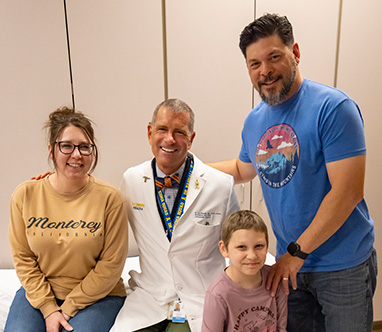
“The care UC Davis provided was phenomenal,” Jeremy said. “They were so positive and really helped us through some very challenging times.”
And as for Randall?
“He did a wonderful job and is a really sweet guy. We would definitely recommend him. And, as a matter of fact, I have,” Kacy said. “It’s not just a job for him. It’s what he lives and breathes. He took good care of Sydney and we are really grateful.”
Randall feels fortunate to have had the opportunity to provide care for Sydney.
“The family did their homework and chose the sarcoma team at UC Davis Children’s Hospital for our internationally recognized expertise in caring for these rare pediatric malignancies,” Randall said. “We are so grateful for their trust.”
UC Davis Children's Hospital is the Sacramento region's only nationally ranked, comprehensive hospital providing care for infants, children, adolescents and young adults with primary, subspecialty and critical care. It includes the Central Valley's only pediatric emergency department and level I pediatric trauma center, which offers the highest level of care for its critically ill patients, as well as a level I children’s surgery center. The 129-bed children's hospital includes the state-of-the-art 49-bed neonatal and 24-bed pediatric intensive care and pediatric cardiac intensive care units. For more information, visit children.ucdavis.edu.


